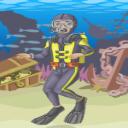Yahoo Answers is shutting down on May 4th, 2021 (Eastern Time) and beginning April 20th, 2021 (Eastern Time) the Yahoo Answers website will be in read-only mode. There will be no changes to other Yahoo properties or services, or your Yahoo account. You can find more information about the Yahoo Answers shutdown and how to download your data on this help page.
Trending News
What made Hiroshima & Nagasaki as the bomb target? Why not Tokyo & Osaka instead?
Just curious. what makes the two cities chosen as the atomic bomb's target while there were more popular cities in japan.
10 Answers
- 1 decade agoFavorite Answer
The commission entrusted with the operation recommended that it be conducted "on populous cities" and "without any warning". Hiroshima was picked because it was a very populated city. Nagasaki was picked because the pilot and crew decided to drop the bomb using a radar instead of crashing into the ocean with the bomb on board due to low fuel and bad weather.
I did do alot of reading on this subject to find these details for you. From various websites.
"The United States decision to drop the atom bomb on Hiroshima and Nagasaki saved over one million American lives which would have been sacrificed by an invasion of Japan."
When the atomic bomb was dropped, President Truman said that it was to make Japan surrender without losing large numbers of American lives in an invasion. Documents proved this to be false.
On August 6, three reconnoissance planes preceded the "Enola Gay", so as to inform it by agreed code of the weather conditions above three of the cities - the bombing was not to be done by radar but by sight, for the sake of maximum precision. The exceptionally fine weather over Hiroshima that morning (predicted since April by a Norwegian meteorologist specialising in the region) gave 10 miles visibility and so confirmed this city as the ideal target. Two observation planes followed the "Enola Gay" at a distance, one to release the measuring devices over the bombed city and one for photography and filming. That made altogether six B-29s, flying practically out of reach of anti-aircraft fire. Further steps had been taken to deter the few capable Japanese fighter-planes and to counter any passive defense measures: in the preceding days the target cities had been regularly overflown by isolated planes which did no bombing. The moment chosen for the bombing was not random one either: accustomed to false alerts, the inhabitants were already busy with their day's work.
The bombing was "a complete success", and President Truman, when he heard of it in mid-Atlantic aboard the ship returning him from the Potsdam Conference, exclaimed: "This is the greatest day in history!" Once home in the USA, he gave a broadcast to the American people, in which he thanked God for favouring the Americans.
On the morning of August 9 it was Nagasaki's turn. In the interim the weather had deteriorated, but it determined the fate of this other city too.
The bad weather and the storms on the path led to a series of problems: drifting off course, excessive use of fuel, one missed rendez-vous, one radio failure. On arrival over the island of Kyushu the "Bock's Car" - the plane with the bomb - headed first for Kokura, its main target, but circled over it in vain because it was covered by cloud. At the controls, young Major Sweeney had to turn back towards base, via Nagasaki. By the time his radar identified the city. The plane no longer had enough fuel to return to its starting-point, Tinian Is, or even to Iwo Jama. The only way to avoid ditching at sea with an atom bomb on board was to head for Okinawa - and that is what he did, on his last drops of fuel, but not carrying the primed bomb which weighed 5 tons. In a tricky situation, Sweeney quickly consulted three members of his crew, and the four decided to drop it by radar, despite orders to the contrary. It was 11.01 a.m., local time. This inaccurate bombing, plus the irregular topography of Nagasaki, explains why "Fat Man" was a disappointment: it ended up causing fewer casualties than "Little Boy". But the reason for the misery of this city was another small technical hitch: if the fuel had flowed properly from a reserve tank, Major Sweeney could have made a different decision... Thus the dead of Nagasaki owe their fate to a silly little blocked pipe.
- 1 decade ago
The Target Committee at Los Alamos on May 10–11, 1945, recommended Kyoto, Hiroshima, Yokohama, and the arsenal at Kokura as possible targets. The committee rejected the use of the weapon against a strictly military objective because of the chance of missing a small target not surrounded by a larger urban area. The psychological effects on Japan were of great importance to the committee members. They also agreed that the initial use of the weapon should be sufficiently spectacular for its importance to be internationally recognized. The committee felt Kyoto, as an intellectual center of Japan, had a population "better able to appreciate the significance of the weapon." Hiroshima was chosen because of its large size, its being "an important army depot" and the potential that the bomb would cause greater destruction because the city was surrounded by hills which would have a "focusing effect".
Secretary of War Henry L. Stimson struck Kyoto from the list because of its cultural significance, over the objections of General Leslie Groves, head of the Manhattan Project. According to Professor Edwin O. Reischauer, Stimson "had known and admired Kyoto ever since his honeymoon there several decades earlier." On July 25 General Carl Spaatz was ordered to bomb one of the targets: Hiroshima, Kokura, Niigata, or Nagasaki as soon after August 3 as weather permitted and the remaining cities as additional weapons became available.
However they surrendered before we bombed more targets. Hiroshima and Nagasaki, just happened to be the first two available targets due to the weather.
- 1 decade ago
I think the correct answer her would be cloud cover. Both Hiroshima and Nagasaki (if memory serves correctly) were secondary targets. HIroshima was the home to Mitsubishi and Nagasaki was a weapons production facility.
- 1 decade ago
I know Nagasaki was a major port city, i believe they had factories in Hiroshima but that might be wrong. Nagasaki was targeted because of its importance to the Japanese receiving goods
- How do you think about the answers? You can sign in to vote the answer.
- Anonymous1 decade ago
Tokyo was the prime target but because of low cloud they had to abandon tokyo and go for there reserve target which was Hiroshima
- 1 decade ago
The first primary target was shrouded in cloud cover and could not be bombed. The second primary target was deemed to beautiful to be destroyed.
- Anonymous1 decade ago
Because total destruction of the Japanese population was not our goal. The message was received loud and clear with the smaller cities.
- 1 decade ago
They were heavily industrialized cities therefore slowing or stopping their economy.
- Anonymous1 decade ago
tokyo had already been firebombed







